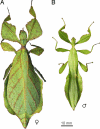The first fossil leaf insect: 47 million years of specialized cryptic morphology and behavior
- PMID: 17197423
- PMCID: PMC1766425
- DOI: 10.1073/pnas.0606937104
The first fossil leaf insect: 47 million years of specialized cryptic morphology and behavior
Erratum in
- Proc Natl Acad Sci U S A. 2007 Feb 6;104(6):2024
Abstract
Stick and leaf insects (insect order Phasmatodea) are represented primarily by twig-imitating slender forms. Only a small percentage ( approximately 1%) of extant phasmids belong to the leaf insects (Phylliinae), which exhibit an extreme form of morphological and behavioral leaf mimicry. Fossils of phasmid insects are extremely rare worldwide. Here we report the first fossil leaf insect, Eophyllium messelensis gen. et sp. nov., from 47-million-year-old deposits at Messel in Germany. The new specimen, a male, is exquisitely preserved and displays the same foliaceous appearance as extant male leaf insects. Clearly, an advanced form of extant angiosperm leaf mimicry had already evolved early in the Eocene. We infer that this trait was combined with a special behavior, catalepsy or "adaptive stillness," enabling Eophyllium to deceive visually oriented predators. Potential predators reported from the Eocene are birds, early primates, and bats. The combination of primitive and derived characters revealed by Eophyllium allows the determination of its exact phylogenetic position and illuminates the evolution of leaf mimicry for this insect group. It provides direct evidence that Phylliinae originated at least 47 Mya. Eophyllium enlarges the known geographical range of Phylliinae, currently restricted to southeast Asia, which is apparently a relict distribution. This fossil leaf insect bears considerable resemblance to extant individuals in size and cryptic morphology, indicating minimal change in 47 million years. This absence of evolutionary change is an outstanding example of morphological and, probably, behavioral stasis.
Conflict of interest statement
The authors declare no conflict of interest.
Figures




Similar articles
-
A tree of leaves: Phylogeny and historical biogeography of the leaf insects (Phasmatodea: Phylliidae).Commun Biol. 2021 Aug 2;4(1):932. doi: 10.1038/s42003-021-02436-z. Commun Biol. 2021. PMID: 34341467 Free PMC article.
-
Under cover at pre-angiosperm times: a cloaked phasmatodean insect from the Early Cretaceous Jehol biota.PLoS One. 2014 Mar 19;9(3):e91290. doi: 10.1371/journal.pone.0091290. eCollection 2014. PLoS One. 2014. PMID: 24646906 Free PMC article.
-
Stick insect in Burmese amber reveals an early evolution of lateral lamellae in the Mesozoic.Proc Biol Sci. 2018 Apr 25;285(1877):20180425. doi: 10.1098/rspb.2018.0425. Proc Biol Sci. 2018. PMID: 29695448 Free PMC article.
-
The early Eocene birds of the Messel fossil site: a 48 million-year-old bird community adds a temporal perspective to the evolution of tropical avifaunas.Biol Rev Camb Philos Soc. 2017 May;92(2):1174-1188. doi: 10.1111/brv.12274. Epub 2016 Apr 8. Biol Rev Camb Philos Soc. 2017. PMID: 27062331 Review.
-
Insect diversity in the fossil record.Science. 1993 Jul 16;261(5119):310-5. doi: 10.1126/science.11536548. Science. 1993. PMID: 11536548 Review.
Cited by
-
High disparity in repellent gland anatomy across major lineages of stick and leaf insects (Insecta: Phasmatodea).BMC Zool. 2024 Jan 2;9(1):1. doi: 10.1186/s40850-023-00189-2. BMC Zool. 2024. PMID: 38163865 Free PMC article.
-
Independent wing reductions and losses among stick and leaf insects (Phasmatodea), supported by new Cretaceous fossils in amber.BMC Biol. 2023 Oct 9;21(1):210. doi: 10.1186/s12915-023-01720-0. BMC Biol. 2023. PMID: 37807035 Free PMC article.
-
Leaves that walk and eggs that stick: comparative functional morphology and evolution of the adhesive system of leaf insect eggs (Phasmatodea: Phylliidae).BMC Ecol Evol. 2023 May 9;23(1):17. doi: 10.1186/s12862-023-02119-9. BMC Ecol Evol. 2023. PMID: 37161371 Free PMC article.
-
Three new genera and one new species of leaf insect from Melanesia (Phasmatodea, Phylliidae).Zookeys. 2022 Jul 5;1110:151-200. doi: 10.3897/zookeys.1110.80808. eCollection 2022. Zookeys. 2022. PMID: 36761451 Free PMC article.
-
Convergent Evolution of Adhesive Properties in Leaf Insect Eggs and Plant Seeds: Cross-Kingdom Bioinspiration.Biomimetics (Basel). 2022 Oct 22;7(4):173. doi: 10.3390/biomimetics7040173. Biomimetics (Basel). 2022. PMID: 36412700 Free PMC article.
References
-
- Evans DL, Schmidt JO, editors. Insect Defenses. Albany: Univ of New York Press; 1990.
-
- Cott HB. Adaptive Coloration in Animals. London: Methuen; 1957.
-
- Mertz DF, Renne PR. Cour Forschungsinst Senckenberg. 2005;255:67–75.
-
- Willmann R. Verh Westd Entom Tag. 2003;2001:1–64.
-
- Gorochov AV, Rasnitsyn AP. In: History of Insects. Rasnitsyn AP, Quicke DLJ, editors. The Netherlands: Kluwer, Dordrecht; 2002. pp. 293–303.
Publication types
MeSH terms
LinkOut - more resources
Full Text Sources


